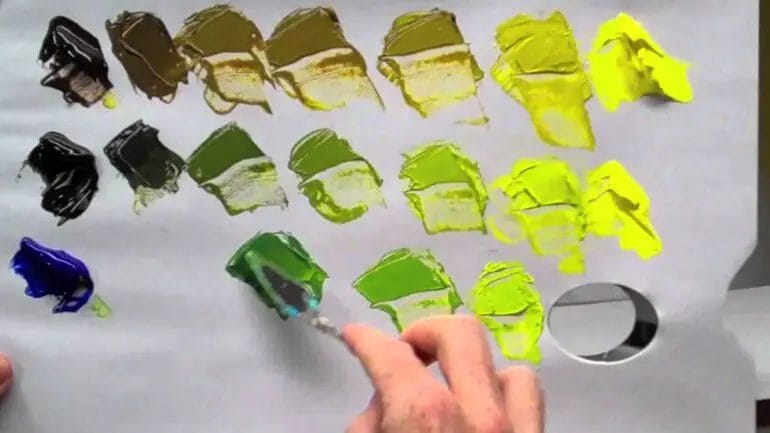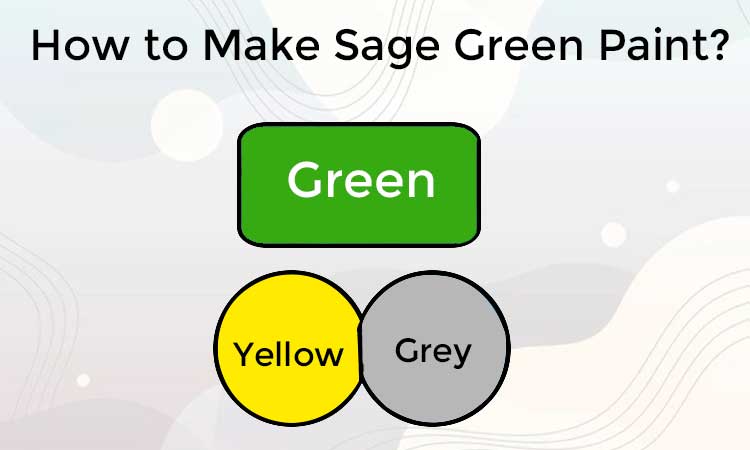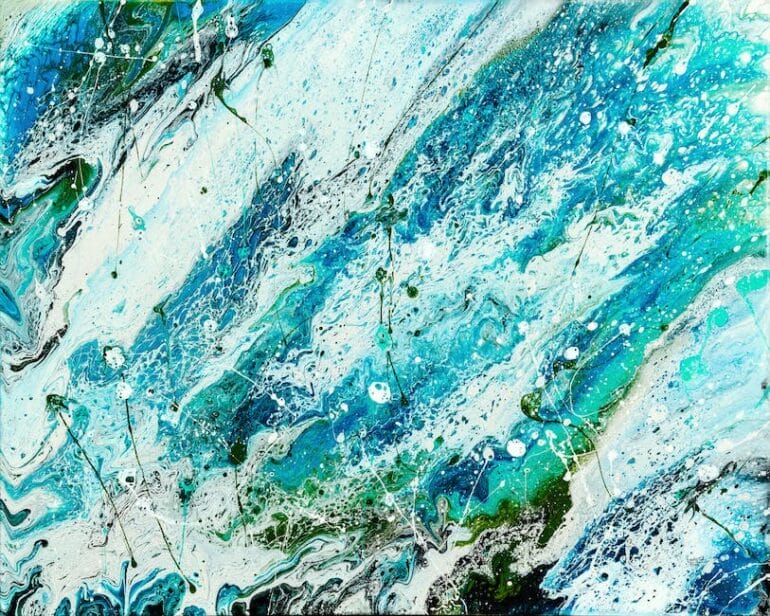Creating your own sage green with acrylic paint is a fantastic way to add a unique touch to your artwork. By blending different shades of green and adding a hint of gray, you can achieve a beautiful and versatile sage green hue. Whether you’re a beginner or an experienced artist, this step-by-step guide will help you master the art of mixing colors and create your perfect shade of sage green.
With acrylic paint, you have the freedom to experiment and adjust the color until it matches your vision. By starting with a base of green and gradually adding small amounts of gray, you can achieve various shades of sage green. It’s all about finding the right balance and tweaking the mixture to suit your desired intensity and tone.
Remember, it’s always a good idea to work with a limited palette of colors when mixing. This allows you to have more control over the final result and ensures that your sage green stays harmonious and cohesive with the rest of your artwork. So grab your acrylic paints, mix up some green and gray, and let your creativity flow!

Best Acrylic Paints for Achieving Sage Green
When it comes to creating artwork, choosing the right acrylic paint is essential to achieve the desired results. If you’re aiming to create the beautiful and soothing color of sage green, selecting the right paints is crucial. In this section, we will explore some of the best acrylic paints that can help you achieve the perfect shade of sage green.
1. Winsor & Newton Professional Acrylic Paint
The Winsor & Newton Professional Acrylic Paint is known for its high-quality pigments and excellent color mixing capabilities. This range of acrylic paints offers a variety of greens, including shades that can be easily mixed to achieve sage green. The smooth consistency of these paints allows for easy application and blending.
2. Liquitex Basics Acrylic Paint
For those on a budget, the Liquitex Basics Acrylic Paint is a great option. This line of acrylic paints offers a decent range of green shades that can be mixed to create sage green. While these paints may not have the same intensity of pigments as higher-end brands, they still provide good coverage and are suitable for beginners or artists on a tight budget.
3. Golden Heavy Body Acrylic Paint
The Golden Heavy Body Acrylic Paint is well-regarded by professional artists for its high-pigment load and smooth consistency. This brand offers a wide range of greens, including shades that can be blended to achieve sage green. The heavy body formula of these paints allows for thick applications and texture building, making them ideal for both traditional and experimental painting techniques.
4. Arteza Acrylic Paint
If you’re looking for a versatile and affordable option, the Arteza Acrylic Paint is worth considering. This set of acrylic paints comes in a wide range of colors, including multiple shades of green. While the pigment load may not be as high as some of the more expensive brands, these paints still offer good coverage and can be easily mixed to achieve sage green.
5. Sennelier Abstract Acrylic Paint
The Sennelier Abstract Acrylic Paint is known for its vibrant and intense colors. This line of acrylic paints offers several shades of green that can be mixed to achieve sage green. The heavy body texture of these paints allows for easy application with a brush or palette knife, making them suitable for a variety of painting techniques.
When it comes to creating sage green with acrylic paints, choosing the right brand and color range is crucial. The Winsor & Newton Professional Acrylic Paint, Liquitex Basics Acrylic Paint, Golden Heavy Body Acrylic Paint, Arteza Acrylic Paint, and Sennelier Abstract Acrylic Paint are all excellent options that can help you achieve the desired shade of sage green. Consider your budget, the level of pigmentation needed, and the desired painting technique when selecting the best acrylic paint for your artwork. Happy painting!

Step-by-Step Guide to Creating Sage Green with Acrylics
Acrylic painting is a versatile and popular medium among artists. One of the challenges artists face is mixing the perfect color. Sage green, with its earthy and calming tones, is a popular choice for landscapes and botanical paintings. In this section, we will provide a step-by-step guide on how to create sage green using acrylic paints.
Materials Needed:
- Acrylic paints (yellow, green, white)
- Palette or mixing surface
- Paintbrushes
- Water
- Palette knife
Step 1: Start with Yellow and Green
Begin by squeezing a small amount of yellow paint and green paint onto your palette or mixing surface. You can adjust the ratio of yellow to green based on the desired shade of sage green. If you prefer a lighter shade, use more yellow. If you want a darker shade, use more green.
Step 2: Mix the Colors
Using a palette knife or a paintbrush, start mixing the yellow and green paints together. Blend the colors thoroughly until you achieve a uniform shade. Keep in mind that a little goes a long way, so start with small amounts of paint and gradually add more if needed.
Step 3: Adjust with White
If your mixture appears too intense or dark, you can lighten it by adding a small amount of white paint. The white will help to soften the color and give it a more muted and subtle tone. Mix the white paint into the sage green mixture until you reach your desired shade.
Step 4: Test the Color
Before applying the sage green paint to your canvas or paper, it’s a good idea to test the color on a separate surface. This will allow you to make any necessary adjustments and ensure that you are satisfied with the shade of sage green.
Step 5: Painting with Sage Green
Once you are happy with the color, you can start using the sage green paint in your artwork. Whether you are working on a landscape, a still life, or any other subject, the sage green can add depth and interest to your painting.
Tips:
- Experiment with different ratios of yellow and green to create variations of sage green.
- Use a clean brush or palette knife when mixing colors to avoid muddying the paint.
- Remember that acrylic paints dry darker, so the color may appear lighter when wet.
- Feel free to add other colors, such as a touch of blue or a hint of brown, to customize the sage green shade.
In summary, creating sage green with acrylics involves mixing yellow and green paints together, adjusting with white if necessary, and testing the color before applying it to your artwork. With practice and experimentation, you can achieve the perfect shade of sage green to enhance your acrylic paintings.

Exploring Different Shades of Sage Green in Acrylic Painting
Acrylic painting is a versatile medium that allows artists to explore a wide range of colors and techniques. One such color that has gained popularity among artists is sage green. Sage green, with its soothing and earthy tones, is a fantastic color to incorporate into your acrylic paintings. In this section, we will delve into the various shades of sage green and how you can use them to enhance your artwork.
Understanding Sage Green
Sage green is a pale, greyish-green color that resembles the foliage of the sage plant. It is a versatile color that can range from light and airy to deep and rich, depending on the mix of pigments used. Sage green is often associated with nature, tranquility, and harmony, making it an excellent choice for landscape paintings or subjects that evoke a sense of calmness.
Creating Light Sage Green
To create a light sage green color, you can start with a base of titanium white and add a touch of green paint. You can use colors like viridian green, phthalo green, or sap green to achieve different variations of light sage green. Gradually add small amounts of green paint to the white, mixing well until you achieve the desired shade. This light sage green can be used to depict fresh foliage, meadows, or other elements in your painting that require a subtle, gentle touch.
If you want to add a bit more depth and vibrancy to your light sage green, you can also experiment with adding a touch of yellow or yellow ochre to warm up the color. This will give your painting a sun-drenched, organic feel.
Exploring Medium and Dark Sage Green
If you’re looking to create medium or dark sage green tones, you can start with a base of green paint and gradually add small amounts of black or brown. This mixture will darken the green and give it a richer, more intense appearance. The key is to add the darker pigments slowly, allowing you to control the depth of the color and avoid overpowering the green.
For a medium sage green, you can use colors like Hooker’s green or olive green as your base, and then add a touch of black or burnt umber. This will create a versatile and earthy green that is perfect for depicting foliage, trees, or plants in your acrylic paintings.
If you’re aiming for a darker sage green, mix together phthalo green or sap green with a small amount of black or burnt umber. This mixture will give you a deep, moody green that can be used to create shadows, add depth, or represent a lush forest in your artwork.
Enhancing Your Artwork with Sage Green
Sage green can be used in a variety of ways to enhance your artwork. Here are a few ideas to incorporate different shades of sage green into your acrylic paintings:
- Use light sage green to create soft, ethereal backgrounds or subtle highlights in landscapes.
- Experiment with medium sage green for depicting trees, foliage, or plants with more depth and texture.
- Introduce dark sage green to add shadows, create contrast, or represent dense forests or secluded areas.
- Combine sage green with other colors like blues, purples, or browns to create unique harmonious color palettes.
Remember to explore different techniques such as dry brushing, glazing, or layering to enhance the visual appeal of sage green in your paintings. These techniques can bring out the texture and depth of the color, adding a realistic touch to your artwork.
In summary, sage green is a versatile color that can add depth, tranquility, and harmony to your acrylic paintings. By understanding the various shades and mixing techniques, you can incorporate sage green into your artwork with confidence. Whether you’re creating landscapes, botanical illustrations, or abstract pieces, the different shades of sage green offer a world of possibilities to explore in your acrylic painting journey.
Enhancing Your Artwork with Sage Green: Creative Ideas
Artistry is a beautiful way to express oneself and evoke emotions in others. The choice of colors plays a crucial role in conveying the intended message and creating the desired impact. One color that has gained popularity in recent years for its subtle charm is sage green. This versatile and calming shade can add a touch of elegance and sophistication to your artwork. In this section, we will explore some creative ideas to enhance your artwork using sage green.
1. Background Bliss
One of the simplest ways to incorporate sage green into your artwork is by using it as a background color. Whether you’re working with acrylics, watercolors, or digital art, a soft wash of sage green can instantly transform the mood of your piece. It provides a peaceful and serene backdrop that can make other colors pop and add depth to the overall composition.
2. Foliage Fantasy
If you’re a fan of nature-inspired themes, sage green can be the perfect choice for depicting foliage in your artwork. Whether you’re painting a lush forest scene or a delicate bouquet of leaves, using varying shades of sage green can bring your depiction to life. Add dimension by layering different tones and textures, creating a realistic and captivating representation of nature.
3. Harmonious Combinations
Sage green is wonderfully versatile and pairs well with a wide range of colors. Experiment with different color combinations to create harmonious and visually striking artwork. For a calming and earthy feel, combine sage green with muted browns and soft creams. To create a pop of contrast, pair sage green with vibrant coral or deep plum. The possibilities are endless, so let your creativity soar!
4. Focal Point Flourish
Using sage green as a focal point in your artwork can add intrigue and draw the viewer’s attention to a specific area. Whether it’s a single object or a central figure, incorporating sage green into the focal point can create a powerful visual impact. Contrast it with complementary colors or use it as a highlight to enhance the overall composition and create a sense of balance.
5. Subtle Texture
Sage green can also be used to add texture and depth to your artwork. Experiment with different techniques, such as dry brushing or palette knife painting, to create interesting textures and visual interest. Sage green can bring out the intricate details and create subtle variations that add richness to your piece.
6. Abstract Elegance
If you enjoy abstract art, sage green can be a fantastic choice to create a sense of tranquility and sophistication. Play with different brush strokes, layering techniques, and shapes to create unique and captivating abstract compositions. Sage green can serve as a grounding color, allowing other vibrant or contrasting shades to come alive on the canvas.
7. Mixed Media Magic
Combining different artistic mediums can yield fascinating results. Sage green can act as a unifying element when working with mixed media. Whether you’re incorporating collage, paper cutouts, or textured elements, sage green can tie everything together and give your artwork a cohesive and harmonious look.
In summary, sage green is a versatile and timeless color that can elevate the beauty of your artwork. Whether you’re using it as a background, incorporating it into nature-inspired themes, experimenting with color combinations, highlighting focal points, adding texture, exploring abstract concepts, or working with mixed media, sage green can bring a sense of elegance and serenity to your creations. So, go ahead and unleash your creativity while enhancing your artwork with the captivating charm of sage green.
FAQs
1. How can I make sage green with acrylic paint?
To make sage green with acrylic paint, you can mix equal parts of yellow and green paint. Start with a base of yellow paint and gradually add green paint until you achieve the desired shade of sage green. Adjust the proportions to lighten or darken the color as needed.
2. Can I mix different shades of green to create sage green?
Yes, you can mix different shades of green to create sage green. Experiment with mixing various greens, such as light green and dark green, until you achieve the desired hue. Adding a touch of yellow or white can help in achieving the perfect sage green color.
3. What other colors can I mix with green to create different shades of sage green?
Aside from yellow, you can mix other colors with green to create different shades of sage green. For a warmer sage green, mix green with a hint of brown or orange. For a cooler sage green, mix green with a touch of blue or gray. Experimenting with different color combinations will help you achieve unique variations of sage green.
Conclusion
In conclusion, learning how to make sage green with acrylic paint is a useful skill for artists and DIY enthusiasts. By combining various shades of green and adding a touch of gray, you can achieve the perfect hue of sage green. Experimenting with different ratios and blending techniques will allow you to create unique and customized shades that suit your artistic vision.
Whether you’re painting landscapes, still life, or adding a touch of nature-inspired color to your home decor, sage green adds a calming and earthy vibe. With the versatility of acrylic paint, you can easily adjust the intensity and tone of sage green to create different moods and atmospheres in your artwork.
So, grab your acrylic paints and brushes, and start exploring the world of sage green. Let your creativity flow and bring the soothing beauty of this tranquil color into your artistic endeavors.
